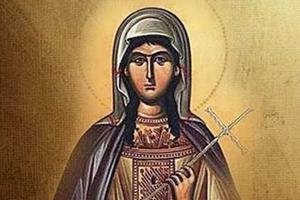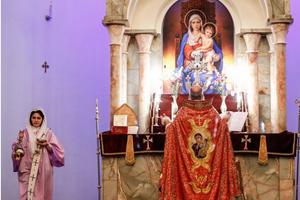How the Catholic Church Sees the Ordination of an Orthodox Church Deaconess
COMMENTARY: Any consideration of women in the diaconate must be grounded in a thorough understanding of the Catholic Church's tradition and divine revelation.

In recent developments within the Greek Orthodox Church of Alexandria, notably the ordination of Angelic Molen as a deaconess, significant theological and canonical questions arise when seen through the lens of Catholic ecclesiology and sacramental theology.
Historical Background
In the early Church, deaconesses played significant roles, especially in the East. By the third and fourth centuries, they were involved in liturgical functions and the baptism of women, as documented in sources like the Apostolic Constitutions and the Council of Chalcedon in AD 451. The Church in the West also had women serving in similar capacities, though less formalized, focusing on baptism and works of charity. Figures such as St. Epiphanius of Salamis provide insight into the ambivalent attitudes toward their ordination at the time.
By the early Middle Ages, the role of deaconesses began to decline in the East, and faded even more definitively in the West, as the Church clarified that sacramental ordination is limited to men.
However, the 20th century and beyond has seen a resurgence of interest in both traditions and the Orthodox Churches have moved toward reinstating deaconesses, particularly in the Greek Orthodox Church of Alexandria and regions like Africa where the Church is expanding.
Angelic Molen and the Alexandrian Orthodox Church
Molen’s ordination marks a noteworthy development within Eastern Orthodoxy, aiming to reinvigorate a role that historically encompassed a variety of functions. While the reintroduction of deaconesses in this tradition is seen as a revival of an ancient ministry, it's crucial to understand the scope and limitations of their roles compared to their male counterparts.
The envisioned role for these deaconesses in the Alexandrian Church includes participating in certain liturgical functions and undertaking pastoral duties that are often associated with ordained clergy. These responsibilities might include assisting in the administration of Holy Communion — a hallmark of diaconal service in many Christian traditions.
However, the liturgical involvement of deaconesses in the Alexandrian Church does not mirror entirely the liturgical prominence and ministerial authority vested in male deacons. Unlike male deacons, who have a more central role during liturgical celebrations, including proclaiming the Gospel and preparing the Eucharistic altar table, the functions of deaconesses are more circumscribed. This distinction underscores a significant variance in the ecclesiastical understanding of the roles within the diaconate, reflecting theological, liturgical and canonical nuances that differentiate deacons from deaconesses.
The role of deaconesses in the Orthodox Church of Alexandria, therefore, should be viewed in a broader ecclesiological context, where their revival represents an attempt to address specific pastoral needs rather than to establish an absolute equivalence with the traditional male diaconate.
Challenges Within the Orthodox Churches
Not all members of the Orthodox Churches view Molen’s ordination favorably. Jeanne Constantinou, a retired professor of Biblical studies, has expressed skepticism regarding the pace of change within Eastern Orthodoxy, casting doubt on the likelihood of broad acceptance for the female diaconate. She noted that Orthodox Christians adhere to tradition and resist changes, and innovations are not embraced lightly.
Constantinou also questioned the broader implications of such ordinations — suggesting that Alexandria’s move shouldn’t be seen as a green light for the ordination of women everywhere — and raised questions about the intended roles of such ordained women, whether as deacons or paving the way to priesthood.
Furthermore, the decision by the Alexandrian Patriarchate may have wider ramifications for the unity of the Church, especially given the ongoing tensions exacerbated by the Russia-Ukraine conflict, potentially intensifying existing divisions and leading to more pronounced splits within the Orthodox community.
Catholic Perspective
From a Catholic perspective, several key theological distinctions must be considered.
In Catholic theology, the distinction between doctrine and discipline is crucial. The sacramental nature of Holy Orders, into which only baptized males can be ordained, constitutes a matter of doctrine, not merely ecclesiastical discipline. This doctrinal position is rooted in the Church's deep understanding of divine revelation and the unbroken tradition of only ordaining males to the priesthood and diaconate.
While historical instances of deaconesses exist, their roles and functions did not equate to those of their male counterparts in terms of sacramental ministry. The tasks performed by deaconesses in the past, primarily revolving around pastoral and administrative support, particularly in the context of baptism and care for women, did not include sacramental functions reserved for ordained clergy. Such nuances underscore a clear distinction in roles that is not merely cultural but theologically grounded.
While the Catholic Church recognizes the validity of Holy Orders conferred in the Orthodox Churches due to shared apostolic succession and sacramental form, this recognition is predicated on the ordinations being conducted within the theological and canonical norms mutually understood and accepted. The introduction of female deaconesses as an apparent part of the sacramental economy represents a significant divergence from recognized Orthodox and Catholic practice and understanding.
Pope Francis and the Question of Women in the Diaconate
Pope Francis has approached the question of women in the diaconate with caution, reflective of the Church’s long theological tradition and the need for a deep, historical and theological foundation before making any sacramental decisions. In conversations and statements, he has consistently emphasized the need to understand the Church's doctrine fully before making any changes that could affect the nature of Holy Orders.
In line with his predecessors, Pope Francis has stressed that any consideration of women in the diaconate must be grounded in a thorough understanding of the Church's tradition and divine revelation. The question is not merely disciplinary but touches on the deeper doctrinal understanding of the sacraments and the priesthood. Moreover, recent updates to the Code of Canon Law, specifically under the guidance of Pope Francis, have reaffirmed the traditional understanding of Holy Orders. The changes include severe penalties for attempting to ordain women (Canon 1379.3), indicating a reinforcement of the current doctrinal stance rather than an opening toward ordaining women to the diaconate.
The Catholic Church, adhering to its doctrinal integrity and theological tradition, does not recognize the ordination of women to the diaconate as valid within the framework of sacramental Holy Orders. This stance is not merely a reflection of historical practice but a profound theological commitment to the nature of the Church and the sacraments as instituted by Christ.
The case of the Orthodox Church of Alexandria ordaining a female deaconess, therefore, presents a complex ecumenical challenge. It underscores the need for ongoing dialogue between the Churches, particularly in areas where significant theological and sacramental differences emerge.

















